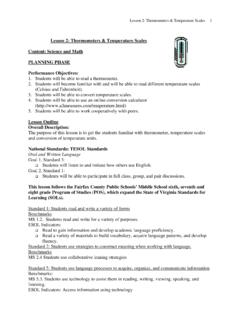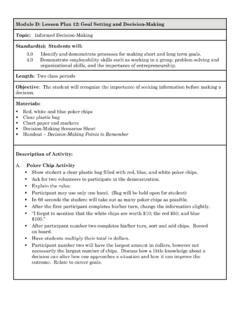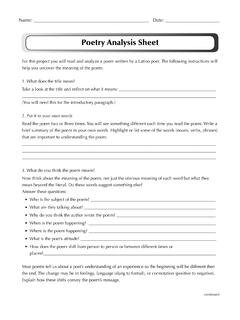Transcription of CASE STUDY: LESSON PLAN (EXAMPLE) Teacher: When …
1 PLEASE USE THIS EXAMPLE ONLY AS A GUIDE AND DO NOT COPY ANSWERS DIRECTLY INTO YOUR OWN WORK! Friendly reminder not to plagiarize the example! CASE STUDY: LESSON PLAN (EXAMPLE). Teacher: Arnie Duncan Case Study: Jeff Judd When creating the LESSON plan, use the LESSON Topic: Sailing blank LESSON plan template found in the instructions! LESSON Title: Tacking a Sailboat Grade Level: Adult LESSON Author: Adapted from Tom Lochhaas How to Tack a Sailboat: If you use or adapt another person's LESSON , make sure you give that Length of LESSON : 1 full day person credit with a viable citation!! Materials Needed: 3 stools, 1 broom, 1 line, small sailboat, an ocean!, and mild winds (10-15. knots)a nonacademic If you have chosen subject, then you will need to create your own standard/objective STANDARDS.
2 Demonstrate basic seamanship and sailing skills. (This standard was created by the teacher). OBJECTIVES. At the end of this LESSON , the Case Study will tack (turn) a sailboat safely while sailing in mild winds. (This objective was created by the teacher). RATIONALE: To make it much easier on yourself, I. I think this objective is very important because to become a good sailorwould a person hasencourage highly to be ableyou to to turn a boat quickly and efficiently to get to a desired destination. Tacking a sailboat (bringing the choose ONE learning objective with front end of a sailboat through the wind) is one of the most basic ways one of getting or two to a destination action verbs. Remember, because the boat is already heading into the wind.
3 Being able to tack theyousailboat effectively have to assess every action! means that the boat's speed can be maintained and you can get to where you are going faster. For example, a slow and inefficient tack can bring the boat to a standstill. Being able to tack effectively also means that any danger is minimized because all persons on board are aware of the maneuver and that unexpected events don't occur. For example, a tack that is too abrupt may spin the boat in directions not intended and this may cause people on board to fall down and hurt themselves. The techniques for tacking are also fundamental for more difficult maneuvers such as jibing and heave to. Finally, effective tacks display good seamanship because it requires that the sailor gets the gear and items necessary for the tack are prepared and ready to go.
4 Learning how to tack well is learning how to sail well. Why are you teaching that? This is a question that educators get often, and so being able to articulate the importance of the objective is important. One thing to avoid is to argue that the objective is important because it focuses on you and your interests. You should also focus on why the objective is critical for the Case Study to learn! PLEASE USE THIS EXAMPLE ONLY AS A GUIDE AND DO NOT COPY ANSWERS DIRECTLY INTO YOUR OWN WORK! CRITICAL! Assessment Must create rubric must match the if open response objective's action verb! is required! ASSESSMENTS. The action verb in the objective is tack , which requires the Case Study to do something that involves several possible answers, and thus, the assessment that matches is a performance assessment because that assessment involves doing and open responses.
5 This is the actual Assessment Task: assessment! While sailing in mild winds, you will tack to port and tack to starboard safely. In your tacking, you will be expected to accurately evaluate conditions before the tack, communicate clearly to your crew, and complete the maneuver smoothly and safely. Notice that same action across rubric, but get Assessment Task Rubric: progressively worse Criteria Exceeds Meets Proficiency Developing Proficiency Below Proficiency ThisScore is the scoring tool Tack Proficiency (4) (3) (2) (1). (100-90%) (89-70%) (69-60%) (59% or below) of the assessment! Preparing Conditions for Conditions for Conditions for tacking Conditions for (rubric). to Tack tacking are tacking are mostly are somewhat adequately tacking are not adequately adequately evaluated before adequately evaluated evaluated before evaluated before maneuver (gear, lines, before maneuver Place maneuver (gear, maneuver (gear, wind, crew, new point of (gear, lines, wind, criteria lines, wind, crew, lines, wind, crew, sail) crew, new point of here new point of sail).))
6 New point of sail) sail). Initiating Initiation of Initiation of Initiation of tacking is Initiation of tacking Tack tacking is clearly tacking is clearly somewhat clearly is not clearly communicated to communicated to communicated to crew. communicated to crew. Crew are crew. Crew are Crew are given some crew. Crew are not BASED ON given adequate given mostly adequate time to prepare given adequate time ACTION time to prepare for adequate time to for tacking. to prepare for VERB tacking. prepare for tacking. tacking. Tacking Tacking maneuver Tacking maneuver Tacking maneuver is Tacking maneuver is (what does Maneuver is smooth and is mostly smooth somewhat smooth and not smooth and action look efficient. Little and efficient. Some efficient.
7 Loss of boat efficient. Loss of boat like?) loss of boat speed Break loss of boat down speed criteria speedinto specific results from tack speed results from results from tack results from actions tack and new point of line is tack and new point of and new point of and new point of somewhat maintained. line is not line is maintained. line is maintained. maintained. Port and Tacking maneuver Tacking maneuver Tacking maneuver on Tacking maneuver on Starboard on either port or on either port or either port or starboard is either port or Tacking starboard is starboard is mostly somewhat equally starboard is not equally proficient equally proficient proficient as determined equally proficient as as determined by as determined by by above criteria.
8 One determined by above above criteria. above criteria. type of tack is easier to criteria. Only one demonstrate than other. type of tacking can be done. Total PLEASE USE THIS EXAMPLE ONLY AS A GUIDE AND DO NOT COPY ANSWERS DIRECTLY INTO YOUR OWN WORK! INSTRUCTION. An instructional strategy that matches the performance assessment is hands-on and to have the Case Study actually perform the steps involved in tacking a sailboat. I. ANTICIPATORY SET Land Drill (2 hours). 1. Teacher and Case Study meet in a room where teacher has set up 3 stools, 1 broom, and 1 line to represent the arrangement of a sailboat that is ready to tack. Instruction should begin with an opener Visuals always help instruction! (also called warm-up, focusing activity, etc.)
9 Instruction should broken down in steps! Notice that the instruction has enough detail that another teacher can follow it! 2. Teacher begins by asking Case Study to explain how the H k le a sailing canoe makes turns in the ocean and what Native Hawaiians knew about the ocean and wind. 3. After a brief discussion, teacher then asks Case Study to read through steps of the land drill to himself/ herself or to state step using picture as a guide. 4. Teacher then asks Case Study to describe steps of land drill or draw pictures. 5. Teacher evaluates level of Case Study's conception of tacking, and then takes the Case Study through each step that the Case Study is not proficient at and slowly reads over the steps with the Case Study. Teacher does this several times.
10 6. Teacher then has Case Study demonstrate the land drill by himself/herself first. Again, teacher evaluates proficiency of Case Study's land drill ability. 7. Teacher then takes the Case Study through each step and models each step and holds corresponding cards with the commands written out. Teacher has Case Study perform each step until Case Study can do the step with ease. 8. Teacher then models to the Case Study the entire drill. Teacher then has Case Study perform entire drill. Teacher provides feedback. 9. Case Study practices drill over and over until entire drill can be done with ease. II. MAIN ACTIVITY Tacking the Sailboat (5 hours). 1. After completing the land drill, the teacher has the Case Study practice the land drill on the actual sailboat while the sailboat is docked to the pier.











